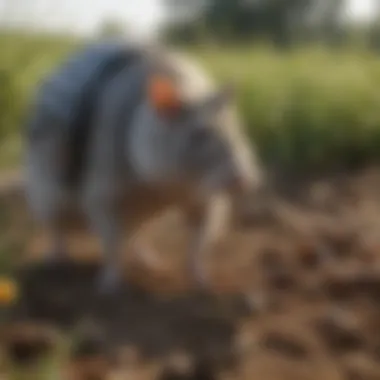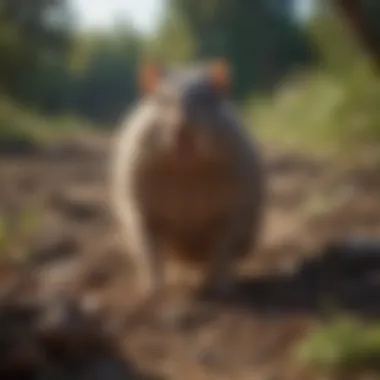Understanding Vermin Control: A Comprehensive Overview


Intro
Vermin control is a vital aspect of agricultural practices and public health management. It encompasses a range of methods aimed at reducing or eliminating pests that pose threats to crops, livestock, and even human health. In an era where environmental sustainability is increasingly important, understanding vermin control is essential for farmers and industry professionals alike.
This article seeks to illuminate various facets of vermin control, covering topics like its definition, significance, and the methodologies employed in its practices. As we navigate through the intricacies of vermin management, we'll discuss its implications for agriculture and public health, as well as explore current trends and innovative solutions that address common challenges.
Whether you are a farmer looking to protect your crops or an enthusiast eager to learn more about sustainable agricultural practices, the following sections will provide essential insights into effectively managing vermin.
Vermin Control: An Prelude
Vermin control plays a critical role in safeguarding crops, public health, and overall ecological balance. The presence of vermin—comprised mainly of rodents, insects, and certain birds—poses significant threats to agriculture and human well-being. This introduction aims to elucidate why vermin control is not merely a matter of preference but a necessity for sustainable practices in agriculture.
Effective vermin control methods help in maintaining crop productivity. For farmers, the ongoing battle against pests translates into a direct impact on yield. Without appropriate measures, crops can sustain devastating damage, resulting not only in financial loss but also a deterioration of local food supply. Therefore, understanding the nuances of vermin control is integral for anyone involved in farming.
Moreover, the implications of not addressing vermin issues stretch beyond economic losses. Rodents and insects can be vectors for diseases, leading to health risks for humans and livestock. This dimension makes it vital that farmers and agricultural professionals identify effective vermin control strategies.
In addition, the complexities associated with ecological balance must be acknowledged. Overreliance on chemical controls can lead to environmental degradation, prompting a need for a more harmonious approach such as Integrated Pest Management (IPM). These elements emphasize that vermin control is not a one-size-fits-all endeavor but requires thoughtful consideration of methods and their impacts.
"Understanding vermin control ensures the sustainability of agriculture and the safety of communities."
In summary, the introduction to vermin control encapsulates its significance across multiple spheres—economic, health-related, and ecological. This understanding lays the groundwork for a deeper dive into specific types of vermin and the methodologies employed in their control.
Types of Vermin
Understanding the types of vermin is crucial for developing effective control measures. Vermin are not just mere nuisances; they pose genuine threats to agricultural productivity, public health, and economic stability. Different types of vermin bring unique challenges, each requiring tailored approaches for management and control.
Rodents
Rodents, such as mice and rats, are among the most common vermin in many environments. They breed rapidly and can establish large populations in a short time. Their reproductive rate creates a significant challenge for farmers, as they consume crops and contaminate food sources with their droppings. This consumption can lead to reduced yield, affecting not only farmer income but also food supply chains.
Moreover, rodents can spread diseases to humans and livestock. They are known carriers of pathogens such as hantavirus and leptospirosis, which pose serious health hazards. Controlling rodent populations is vital not just for crop protection, but also for safeguarding community health.
Insects
Insect pests, including aphids, locusts, and beetles, can wreak havoc in agricultural fields. These pests can inflict direct damage by feeding on crops or indirectly affect their health by transmitting diseases. The economic cost associated with insect infestations can be staggering, leading to increased costs in insecticides and lost productivity. Farmers must invest time in monitoring and identifying pest species to deploy the correct control measures.
Effective management of insect pests can often involve integrated pest management (IPM) strategies, utilizing both chemical and biological control methods. Farmers need to adopt a holistic approach to minimize reliance on harmful pesticides and reduce environmental impact.
Birds
Birds can be a significant menace to agriculture. Species like crows and sparrows feed on seeds, fruits, and vegetables, leading to substantial crop losses. Depending on the type of crops, different methods may be employed for control. Netting, scare tactics, and habitat management can collectively mitigate the threat that birds pose.
Importantly, farmers need to be mindful of local wildlife regulations when implementing control measures. Some birds may be protected species, and measures taken must not infringe upon legal protections.
Other Species
This category is quite broad, covering various animals such as rabbits, raccoons, and even deer. Each species has its behavioral patterns and preferences that can influence their impact on agriculture. For instance, deer often browse on young plants, while raccoons may raid crops at night.
Managing these other species generally requires a mix of fencing, repellents, and habitat modification. Understanding their behavior is essential to prevent them from becoming a significant threat to crops. Farmers need to remain vigilant, as these species can adapt quickly, requiring ongoing adjustments to management techniques.
Effective vermin control involves recognizing the type of vermin present, understanding their behavior, and deploying the most suited methods for mitigation.
By being aware of the various types of vermin and their implications, farmers can take proactive steps to safeguard their crops and ensure a more sustainable agricultural practice.


Impact of Vermin
Vermin have a considerable impact on various aspects of agriculture and human health. Understanding their effects is crucial for farmers, policy-makers, and public health officials. This section will dissect the diverse repercussions that vermin present, focusing on crop yield, health risks, and economic consequences.
Effects on Crop Yield
Vermin can significantly reduce crop productivity. In agriculture, rodents, insects, and birds often invade fields, gardens, and stored grains. Their feeding behaviors can lead to substantial losses. For instance, rodents are known to consume seeds and seedlings, which hinders plant growth. Insects may feed on crops or transmit diseases, resulting in diminished harvests.
Some studies indicate that losses can reach up to 20%-30% in certain crops due to such infestations. This has extensive implications for food supply and farm sustainability. Understanding these effects helps farmers recognize when to implement control measures, preserving their investments and ensuring a stable food supply.
Health Risks
The role of vermin in the transmission of diseases cannot be overlooked. Many insects and rodents harbor pathogens that pose health risks to humans and livestock. For instance, rodents are known carriers of hantavirus and leptospirosis, while certain insects can transmit diseases like West Nile virus.
Health risks are not limited to direct transmission. Contamination of food supplies by vermin feces or urine can lead to a range of foodborne illnesses. Affected crops or products may become unfit for consumption, further affecting health. The connection between vermin and health underscores the necessity for effective control measures to protect both public health and agricultural stability.
Economic Consequences
The economic implications of vermin infestations are profound. Farmers incur direct costs from lost crops, increased control measures, and the need for additional resources. The financial strain can be significant, particularly for small or medium farms. Moreover, long-term infestations can lead to decreased land value, reducing a farmer's overall investment potential.
Economic consequences also ripple through the entire farming community. Increased consumer prices and reduced availability of products may emerge due to failed harvests. These situations can lead to a general decline in market confidence, compelling governments and organizations to invest in better vermin control strategies.
Addressing vermin effectively is not just about safeguarding crops; it's also critical to supporting the economy and protecting public health.
Thus, recognizing the impact of vermin is fundamental for informed decision-making. Understanding these elements allows for proactive measures in farming practices, policy creation, and health protocols.
Vermin Control Methods
Vermin control methods are essential components in ensuring agricultural productivity and public health safety. The choice of method can significantly affect the effectiveness of vermin management. Each method has specific strengths and weaknesses, requiring careful consideration based on the type of vermin, the environment, and the underlying objectives.
Mechanical Control Techniques
Mechanical control techniques are often the first line of defense against vermin. These methods involve physical means of removal or deterring vermin without chemical interventions. Key techniques include:
- Traps: Snap traps, glue boards, and live traps can effectively reduce rodent populations. Choosing the right type hinges on the specific species being targeted.
- Exclusion: This involves sealing entry points to prevent vermin from accessing buildings or crops. Simple fixes like mesh screens can block entry for rodents, while proper storage of food can discourage various pests.
Using mechanical measures has benefits such as low environmental impact and immediate results. Nonetheless, these methods may require regular monitoring and maintenance to ensure effectiveness.
Chemical Control Options
Chemical control options offer potent solutions for managing larger infestations of vermin. Pesticides, rodenticides, and insecticides can rapidly reduce pest populations. Important considerations include:
- Selectivity: Chemical products vary in their targeted effectiveness. It's crucial to choose a product based on the specific pest and crop being impacted.
- Application Methods: Chemicals can be applied as sprays, baits, or granules, depending on the product and pest nature. Knowing the application method can influence efficacy greatly.
While chemical control can provide immediate results, caution must be exercised. Relying solely on chemicals may lead to resistance over time. Therefore, integrated approaches are often recommended.
Biological Control Strategies
Biological control strategies harness natural predators or parasites to manage vermin populations. This method is particularly useful for long-term pest management. Some strategies include:
- Predator Release: Introducing natural enemies such as cats for rodent control or certain insects for pest management can create a balanced ecosystem.
- Microbial Insecticides: Products derived from bacteria or fungal pathogens that specifically target insect pests present an environmentally friendly choice.
Biological methods help maintain ecological balance but often work slowly. Patience is required as these methods establish over time.


Integrated Pest Management (IPM)
Integrated Pest Management (IPM) is a comprehensive approach combining various control methods to manage vermin sustainably. It emphasizes:
- Monitoring: Regularly assessing pest populations helps in making informed decisions based on actual data.
- Threshold Levels: Establishing action thresholds determines when intervention is necessary. Not every pest presence requires treatment, thus conserving resources.
- Multi-faceted Strategies: IPM includes a mix of mechanical, chemical, and biological methods tailored to specific conditions.
This layered approach maximizes the effectiveness of vermin management while minimizing environmental impact. Notably, IPM empowers farmers to take proactive control over their vermin issues.
"The goal of IPM is not to eliminate all pests, but to manage them to acceptable levels."
Ultimately, understanding these vermin control methods allows farmers and agricultural professionals to devise effective strategies. A balanced combination of techniques often leads to sustainable, long-term management results.
Sustainable Vermin Control
Sustainable vermin control focuses on managing pests through methods that are environmentally friendly and socially responsible. This approach minimizes the negative impacts of traditional vermin control techniques on ecosystems, human health, and biodiversity. In today’s context of increasing environmental awareness, sustainable practices are not only important but necessary for the well-being of agricultural systems. Farmers and industry professionals must adopt measures that are effective yet have a lower ecological footprint.
Ecological Considerations
Ecological considerations in sustainable vermin control involve understanding how various control methods affect the environment. Key points of focus include:
- Biodiversity Protection: Maintaining a balance in the ecosystem is vital. Overuse of chemical pesticides can lead to the destruction of beneficial insects and other wildlife.
- Soil Health: Certain chemical methods can degrade soil quality. Sustainable practices, like natural repellents and biological controls, help preserve soil integrity.
- Water Resources: Runoff from chemical treatments can pollute water supplies. Techniques such as integrated pest management help mitigate this risk.
Incorporating nature-based solutions ensures that control methods align with ecological principles. For example, using predators or parasites to control pest populations can naturally reduce vermin without harming the environment.
"Sustainable vermin control seeks harmony between agricultural needs and ecological integrity."
Community Involvement
Community involvement is key to successful sustainable vermin control. Engaging local stakeholders can enhance control measures through collaboration and collective action. This includes:
- Education and Training: Providing farmers and community members with knowledge on sustainable practices empowers them to take action against vermin responsibly.
- Shared Resources: Community efforts can lead to the development of shared pest control resources. This minimizes costs and promotes efficiency.
- Feedback Mechanisms: Involving local communities allows for effective monitoring of pest populations and the impact of control methods. Communication channels ensure that farmers can share their experiences and insights, improving strategies collectively.
Fostering a sense of community in vermin control initiatives can lead to more sustainable outcomes, ensuring a resilient agricultural landscape for future generations.
Regulatory Framework
The regulatory framework surrounding vermin control plays a pivotal role in ensuring that methodologies for managing vermin are both effective and compliant with legal standards. Understanding these regulations is crucial for agriculture farmers and industry professionals who are implementing pest management strategies. By following established laws and guidelines, stakeholders can reduce risks associated with vermin control and promote safer agricultural practices.
Legal Regulations
Legal regulations vary by region and can encompass a range of factors including the types of chemicals that can be used, restrictions on specific methods of control, and guidelines for humane treatment of animals. These regulations are designed to protect not just crops, but public health and the environment.
- Chemical Usage: Most jurisdictions have specific restrictions on the use of pesticides and rodenticides. Farmers should check lists provided by organizations such as the Environmental Protection Agency (EPA) or local agricultural departments.
- Humane Practices: Laws often mandate humane treatment of wildlife, emphasizing responsible methods of control. Non-lethal approaches such as trapping and relocation may be required in certain areas.
- Reporting Requirements: Certain regions enforce strict reporting requirements for pesticide use, ensuring that harmful chemicals are not applied recklessly.
Adhering to legal regulations not only helps avoid potential fines and legal issues, but also supports environmental conservation efforts.
Compliance Guidelines
Compliance guidelines provide a practical framework for farmers and pest control professionals to follow. These guidelines help ensure practices meet legal standards while promoting effective vermin management.
- Training and Certification: Engaging in training programs for pest management can enhance understanding of compliance. Certified applicators often have access to resources that ensure they are using the safest and most effective practices.
- Integrated Pest Management (IPM): This method emphasizes an approach that combines multiple strategies for pest control. By integrating biological, cultural, and chemical controls, farmers can adhere to compliance guidelines more effectively.
- Documentation: Properly documenting pest control activities is essential. This can involve maintaining records of substance usage, methods employed, and any incidents of pest infestation.
Compliance ensures that farmers are not only protecting their crops but also upholding the standards set by governing bodies to promote sustainability.


By familiarizing themselves with both legal regulations and compliance guidelines, farmers can create a responsible and sustainable approach to vermin control, fostering a healthier agricultural environment.
Recent Innovations in Vermin Control
Recent innovations in vermin control play a critical role in enhancing the effectiveness of pest management strategies. These advancements are necessary to address the growing challenges posed by vermin in agricultural settings. As farmers and professionals look for solutions, innovations contribute to more sustainable and environmentally friendly approaches. They also reflect a shift in understanding how modern technology can assist in managing pest issues with reduced reliance on traditional methods.
Technological Advancements
Technological advancements have revolutionized how vermin control is approached. One significant development is the use of smart traps, which rely on sensors to detect vermin activity. These traps can notify users via mobile applications when vermin are captured, allowing for timely responses. This minimizes the time pests remain unchecked in agricultural fields.
Another noteworthy advancement is drone technology, which offers a bird's-eye view of fields. Drones can monitor large areas for signs of rodent activity, making it easier to identify hotspots of pest infestation. They can also carry out targeted treatments, reducing chemical usage and potential harm to beneficial organisms. The integration of artificial intelligence in pest management systems allows for more precise data analysis, improving decision-making processes in vermin control efforts.
Research and Development
The field of research and development continues to play an essential part in enhancing vermin control strategies. Academic institutions and agricultural organizations are collaborating to study biological control agents. These agents, such as beneficial organisms that prey on pests, present a natural solution to combatting vermin. Research has shown that when correctly implemented, these agents can maintain pest populations at manageable levels without relying heavily on chemical methods.
Another area of focus is developing resistance management strategies. Given that some vermin have shown resistance to conventional pesticides, new research aims to explore how to mitigate this issue. This includes formulating products that combine different modes of action to reduce resistance development.
"Investing in research and development is key to sustainable vermin control, ensuring that agricultural practices evolve alongside the pests they aim to manage."
Future Trends in Vermin Control
Understanding the future trends in vermin control is crucial for several reasons. The agricultural landscape is constantly shifting due to technological innovation, changing regulations, and evolving environmental practices. Farmers and industry professionals must stay ahead of these trends to ensure effective vermin management. This section delves into two key aspects of future trends: shifts in agricultural practices and global perspectives on vermin control.
Shifts in Agricultural Practices
Recent years have seen significant shifts in agricultural practices influenced by sustainability and technology. Modern farmers are adopting integrated pest management systems. This approach combines biological control methods, cultural practices, and limited use of synthetic chemicals to manage vermin populations, thereby minimizing environmental impact. As the demand for organic products continues to rise, techniques such as companion planting are gaining traction. This method uses certain plant species to deter pests naturally, demonstrating a shift towards more ecological pest management strategies.
Additionally, precision agriculture is becoming more prevalent. Utilizing data analytics and advanced technologies, farmers can monitor their fields more efficiently and determine the optimal time for interventions. This targeted approach not only improves yields but also reduces the likelihood of vermin infestations by disrupting their breeding cycles.
Global Perspectives
The approach to vermin control can vary widely across different regions. Countries are facing unique sets of challenges that influence their strategies. In developed nations, there is a trend towards stricter regulations on chemical use. This results in growing interest in sustainable methods such as biological controls and habitat management. Conversely, in developing countries, the emphasis is often on immediate and cost-effective solutions, which might rely more heavily on traditional chemical methods.
Moreover, international collaboration is important. Sharing research and insights across borders can lead to innovative solutions. Programs focusing on cross-regional pest management strategies make it easier to address transboundary pest issues. This cooperation can enhance overall agricultural productivity and food security worldwide.
"The future of vermin control lies in understanding both local practices and global trends. Knowledge exchange is vital for effective solutions."
Overall, keeping up with these shifts in agricultural practices and global perspectives is essential for effective vermin control efforts. As the landscape of agriculture continues to evolve, so too must the strategies employed to manage and mitigate the impact of vermin.
Finale
In summary, the discussion around vermin control is vital for numerous reasons. First, the topic underscores the significance of effective management strategies aimed at mitigating the detrimental impact vermin can have on agriculture, public health, and economic stability. Recognizing various types of vermin helps farmers to tailor their approaches based on specific hazards presented by rodents, insects, or birds.
Secondly, the evolving methods in vermin control reflect a growing awareness of sustainable practices that are essential in modern agriculture. Integrating ecological considerations fosters a balance between pest management and environmental stewardship. Therefore, a comprehensive understanding of both technological advancements and traditional practices is necessary for effective vermin control.
Additionally, the legal and regulatory framework helps professionals stay compliant while maintaining effective practices. This awareness is crucial in preventing potential legal complications in their operations.
Ultimately, implementing effective vermin control methods not only protects crops but also safeguards public health and wellness. The benefits span from higher yields and reduced losses to healthier community environments. These considerations might influence practices at individual farm levels and resonate in broader agricultural landscapes.
Key Takeaways
- Effective vermin control is critical for agricultural productivity and public health.
- Understanding different types of vermin aids in customized management strategies.
- Sustainable methods must balance pest control with ecological health.
- The legal framework for vermin control ensures compliance and effectiveness.
- Implementing these strategies yields economic benefits and safeguards community health.
Call to Action for Farmers and Professionals
Farmers and industry professionals are called upon to adopt a proactive approach to vermin control. It is important to:
- Assess their operational environments regularly for potential vermin threats.
- Stay informed on the latest sustainable practices and technologies in pest management.
- Collaborate with local authorities for proper compliance with regulations.
- Engage in community discussions around sustainable agricultural practices and share knowledge.
By taking these steps, they can contribute not only to their own success but also to a more sustainable future in agriculture. The time to act is now.



